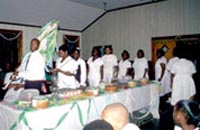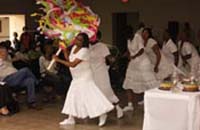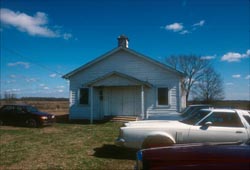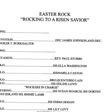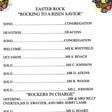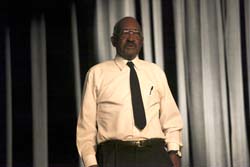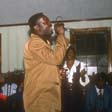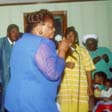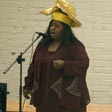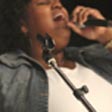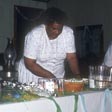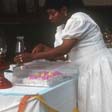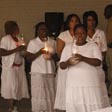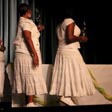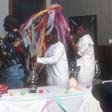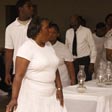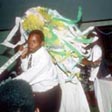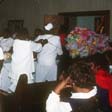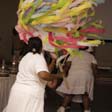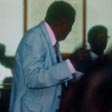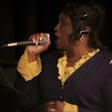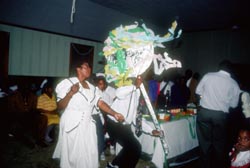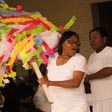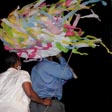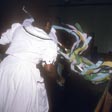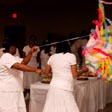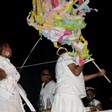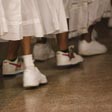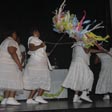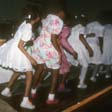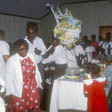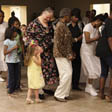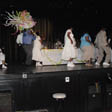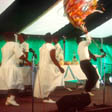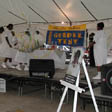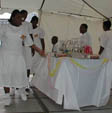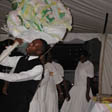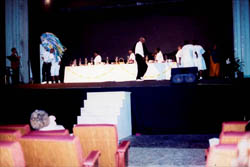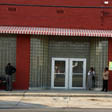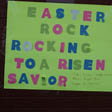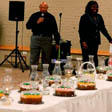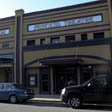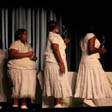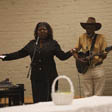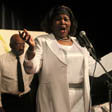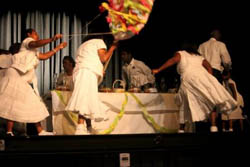Introduction to Delta Pieces: Northeast Louisiana Folklife
Map: Cultural Micro-Regions of the Delta, Northeast Louisiana

The Louisiana Delta: Land of Rivers








Ethnic Groups










Working in the Delta








Homemaking in the Delta




Worshiping in the Delta




Making Music in the Delta




Playing in the Delta







Telling Stories in the Delta



Delta Archival Materials
Bibliography

"Everyone Rockin' Together": Continuity and Creativity in the Louisiana Delta Easter Rock
By Susan Roach
In Memory of Ellen Addison1
One of the most spectacular folk traditions documented for the Delta Folklife Project, Easter Rock, an Easter eve vigil ceremony, commemorates the death and resurrection of Christ.2 Easter Rock belongs to the category of traditional events called "rocks" associated with the old plantation churches (usually Baptist) in the Mississippi Delta floodplain of north Louisiana and has much in common with other African American religious ring shout traditions, according to Janet Sturman (1993: 24) and Joyce Jackson (2006).3 While the tradition is said to reach back to the antebellum period in Louisiana, today only one group appears to be continuing this Louisiana Delta tradition: the Winnsboro Easter Rock Ensemble, as the group named itself for performances of the tradition in state and national folklife festivals. Various factors including modernity, losses of group members and performance venues, and the effects of public presentation have threatened the continuity of the Winnsboro Easter Rock's performance of the tradition, but the group's creative responses have maintained the tradition and heightened its visibility in the Winnsboro community and beyond. A look at the Winnsboro Easter Rock service and public performances, including the context, the participants, and the sequence of acts and how these have developed over the past eighteen years, will shed light on the continuity and creativity in the tradition.
Easter Rock History and Scholarly Documentation
The contemporary Winnsboro Easter Rock is surprisingly similar to the early rocks described by scholars. Easter Rock's origins are not clear, and scholarship is scanty, with only three major scholarly articles devoted to the subject and one more article including it among several other Africanisms. The first scholarly publication by Mariana and Lea Seale in the Journal of American Folklore (1942) notes that participants remember the tradition as pre-dating the Civil War; therefore, the ritual probably has its origins in the customs of enslaved Africans.4 The Seales' observed three Easter Rock services: two at St. John the Baptist Church, at Dunbarton Plantation, near Clayton in Concordia Parish and another at the Baptist Church on Lemarque Plantation, next to Dunbarton. In the 1942 description, the rocks began with brief testimonial service (called a "cul'n" for covenant), which could be similar to the contemporary service's "devotional," followed by musical performances and an offering (Seale and Seale 1942: 212). Then the pews were turned to face the middle aisle, and a table with a white cloth was placed in the aisle. Interestingly, the Seales' description of the opening of the rock itself prefigures the Winnsboro rock held in the 21st century:
Precisely, at midnight by the deacon's watch, the deacon orders the congregation to "come quiet." Shortly thereafter, the voices of many women and a single man rise in the song, "When the Sancts [sic] Go Marchin' In," and a procession moves into the church through a door at the rear.
At the head of the procession is a Negro man carrying what is called "the banner." The banner is a barrel hoop attached to one end of a six-foot stick. The hoop has, stretched across its area in drumhead fashion, a covering of white crepe paper, and to its circumference is attached tasseled crepe of various bright colors. (1942: 213)
In many ways, the event as described by the Seales is similar to the Easter Rocks documented by subsequent scholars. In 1956, folklorist/musicologist Harry Oster recorded Easter Rock at one of the same churches. Evidently, Easter Rock occurred as far north as Lake Providence and south as Ferriday, according to anthropologist H .F. Gregory, who in 1962 recounted the typical rocks he witnessed growing up in Ferriday. He writes that the basic form of the rock was "exactly the same," from the "Primitive African Baptist Church near Waterproof . . . to the Pittsfield Plantation Church near Ferriday" (1962:18). However, instead of the 12 women bearing 12 lamps and 12 cakes noted by the Seales, these rocks featured 7 women carrying 7 lamps, and 7 cakes. While the Seales had found elders who recalled the symbolism of the objects, Gregory did not find explanations of the symbols (1962:18). From the 1960s until the 1990s, no documentation appears to have been done; however, at Gregory's suggestion, ethnomusicologist Janet Sturman located and documented the ceremony at the Springfield Baptist Church, also in Clayton in 1991.
According to organizer Martha Daniels' presentation for that 1991 Easter Rock, church records at the Springfield Baptist Church in Clayton, show that the church mothers of the St. Paul Baptist Church in Wisner held Easter Rock in 1930, when one of the Springfield Baptist Church deacons saw the ritual and decided to bring it to the Clayton church in 1932 (Sturman 1993: 26-27). Martha Daniels relates that Easter Rock was held sporadically there until the 1990s when the wood structure church was replaced with a brick one.
By 1993 when the Delta Folklife Field School was held to train community scholars for Delta fieldwork, my co-field school leader, H. F. "Pete" Gregory told participants that the ritual seemed to have disappeared. Nevertheless, we encouraged our Delta Folklife Project fieldworkers to inquire about Easter Rock. Shortly before Easter 1994, Annie Staten, a community scholar doing fieldwork on Delta gospel music, inquired about it, and her cousin R. B. Kelly told her that there was still another Easter Rock being held in Winnsboro, the parish seat of Franklin Parish about 50 miles from Clayton. She reported it to me, and we received permission to document the event. For that fieldwork, Staten and I were joined by Kelly and her husband Prince Staten, who shot Super 8 video to add to our audio and photographic documentation.
We learned that the Winnsboro Easter Rock had a long tradition in Winnsboro, although it had not been documented previously. Led by Hattie Addison, this Easter Rock was held just outside Winnsboro at the Original True Light Baptist Church. According to Addison, this church had held Easter Rock since the late 1950s, and was one of several area churches which used to perform the ritual. The church building itself, believed to be over 100 years old, had been moved to its present site on Highway 4 near Winnsboro from the Robinson place. Her mother, Ellen Addison, had been a participant in Easter Rock since childhood in churches near Winnsboro—the Augusta Baptist Church on Mason Plantation and later Cuba Baptist Church; after people began to leave Mason Plantation, the rock moved to the Cuba church and later to the Original True Light Baptist Church, which was Hattie Addison's paternal grandfather's home church; Addison's mother joined it after she married (Addison 2011).
Addison, born in 1953, began attending the rock as a child around age six. She recalls her earliest memories of the rock; her daddy's second cousin "used to pick us up and carry us out there, and we used to stand . . . on top of the car and look in the windows because they had the windows up. You didn't have the air conditioners and all that. And he would pull close to the church by the windows so we could stand up there and watch; that was before I started rocking" (2011).
The Ritual and Its Symbols: Continuity and Variation
The Winnsboro Easter Rock shows much continuity with the Clayton ritual documented in 1992 by Sturman, even though the two groups were not aware of each other. Comparison reveals some regional variation within the tradition. In addition, over the years even within the Winnsboro Easter Rock, creative changes have occurred in the ritual in regard to the banner, the table decor, the apparel of the rockers and the performers, and even the venue. Some of those changes may be due to our Delta Folklife Project documentation and its results.
Time Frame and Set Up
One major change that has occurred in the Winnsboro rock is that their Easter Rock service no longer lasts until Easter morning sunrise. Long time participant in the Winnsboro Easter Rock, Lillie Carter recalls how the time has changed since she began participating at age eight: "We'd start about nine o'clock, and we end at 12 now, but they used to rock all night long; the older people used to rock all night 'til the sunrise the next morning"(Easter Rock Presentation 2001). That is, the service would last until the morning; the rock itself would be interspersed with breaks for more music and food. Hattie Addison attributes the shorter services today to the fact that people want to go to Easter sunrise service, refreshed from sleep. The Winnsboro group began to cut the rock short; now they usually begin around 7 or 8 and stop well before midnight, usually around 10 p.m., which is the approximate time frame of the rock in our initial documentation in 1994. In the past, Addison's family told her that they rocked until the "sun shouts," that is, sunrise. Addison relates how she thought her parents were teasing her about the sun shouting, so she decided to see it for herself, only to discover that the sun would "be rocking, you know; it'd be like it's jumping, and I don't know what made them go out to see that back then, but if you go out there Easter Sunday morning you can see it. . . . But I don't know why it was jumping like, but you could see it was just jumping" (2011). When the rock lasted all night, people brought all types of food, as described by Lillie Carter; "at that time the older people would cook like a whole dinner that night, and they would serve ham, chicken, dressing, and that kind of stuff" (Easter Rock Presentation 2003). When the rock ended by 10 or 12 p.m., the need for heartier food diminished, so food was limited to cakes and punch. Obviously, the Easter Rock tradition is steeped in many beliefs and practices, some of which have survived and others which have disappeared or evolved.
The basic décor for the event has changed little over the years. On the day of the Easter Rock ceremony, the venue for the rock is set up sometime before the actual rock service begins or just before the opening devotional service. Hattie Addison reports that she and her helpers usually set this up in the afternoon, hours before the service. The usual forward-facing pews, which normally face the altar and pulpit, are turned sideways to face the center aisle. A long table, covered with a white cloth, is set in the aisle so that the pews are facing it. Addison concurs with Martha Daniels from Clayton that the white cloth-covered table represents the sepulcher of Christ. This preliminary decoration includes putting crepe paper streamers and Easter eggs and candy on the table. According to Addison, the set up takes time and "a lot of hard work . . . trying to get everything situated, finding decoration and all that. I usually do that myself, but when it come down to cakes and the punch, different ones donate [those]" (2011).
Surprisingly, the order of the Easter Rock service shows little change over time and place. The activities of the service may be outlined by a paper program which is distributed to the congregation, but even without the paper programs, the event follows the traditional pattern. The programs for the 2011 and 2012 Winnsboro Easter Rock show that this group continues to follow the traditional sequence of activities in the ceremony.
Descriptions of the earlier Easter Rocks by the Seales, Oster, Sturman, and Addison were much the same. Typically, before the actual rock begins, the service opens with a congregational song, followed by a devotional, consisting of a hymn, biblical scripture reading, and prayer. As it is in other traditional rural South African American Baptist services, the devotional is led by an elderly deacon, who calls out the hymn, reads the scripture, and delivers a traditional prayer accented with supportive words from the congregation.
In addition, a short sermon by the home (or a visiting) minister followed; in the case of the 1994 Easter Rock, the church minister Reverend J. L. McDowell delivered the sermon; however, in 2011 and 2012 the sermon was omitted. The Easter Rock described in previous accounts as well as today's Winnsboro Easter Rock have all presented an hour or more of musical performances by various singers and musicians (either visiting or local). The 2011 and 2012 Easter Rock programs each listed four solos before the actual rock began; however, other unlisted soloists also performed. The 1994 and 1995 Easter Rocks featured even more music, including some bands with instruments. An offering (or two) is held, and may occur after the first performance of the rock or even before it. Then the actual rock begins.
The Rock Procession
To open the rock, the table is further set with other symbolic objects and provides the opening frame for the major event. Twelve women march in carrying oil lamps, which are placed on the table and lighted, or they may be lighted before they are brought to the table. While the use of lamps and cakes does not vary, in some performances, the number 12 does. This was apparent in our first observation of the rock, where only two lamps were on the table. Evidently, some were broken and could not be used. However, in later Winnsboro performances, twelve lamps were used, as Hattie and Ellen Addison say to "represent the 12 tribes of Israel" (Addison 1994). Occasionally as in 1995, the lamps are placed and lighted before the procession starts.
Gregory reports the use of seven lamps and seven cakes with additional food (1962: 18). Others interviewed have said the lamps are from Christ's parable of the ten virgins (five wise and five foolish) waiting for the bridegroom. In earlier days, according to Gregory (1962:18), all sorts of dishes of food were brought for the table, but today in Winnsboro, décor consists of Easter eggs and white cakes. The women then bring in twelve cakes and red punch (often Kool-Aid); in the past wine was often used instead of punch. Hattie Addison remembers the wine served in her childhood: "They served wine, but it was in an itty bitty . . . cup" (2001). In earlier years Addison reports that "Morgan Davis," a colloquial name for Mogen David wine, was used instead of punch. The cake and wine might well symbolize the body and blood of Christ as they do in communion. Addison also notes her elders telling her "that eggs was used for the breaking of the grave" (Addison 2011).
The cakes today are mainly commercial ring cakes with Easter decorations, but occasionally someone will bake a homemade cake with white icing–highly valued now. Asked about the origin of the 12 cakes, Hattie Addison responds: "I don't know why they used cakes. I asked mother the same thing, she said she didn't know, she just going by other folks did, her grandmother, her mama. . . . I know they said that, it might have been the bread, I know they said that the punch represented the blood" (Addison 2011). She further explains the meaning of the cakes: "The 12 cakes are for the 12 disciples, Jesus broke bread with them and gave us the bread of life" (Addison 1997). Addison notes that in her family's rocks, the cakes did not have to be all white, but light colored (although chocolate cakes were never put on the table but might be left in back with other types of food). The cakes and punch will be served after the rock service ends.
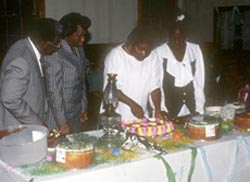
When the rock begins, the church lights are dimmed, and a procession, which Hattie Addison terms "the rockers," enter. According to Katie King, Winnsboro elder who had participated in the rock, the women represent the resurrection of Christ: "They's the ones that went to that grave, the ones that found out Christ had risen, and that's what they was representing in that white" (1994). Addison reiterates this idea: "the women were so concerned about Christ that they went to see about Christ. So this is our ritual part where the women would rock and praise the lord for their risen savior" (1997). In the 1994 and 1995 rocks, just as in earlier rocks held in plantation churches, the rockers entered through the double doors leading into the sanctuary. Traditionally, Addison says that the rockers were twelve women, just as the Seales described, but today an occasional man may be included, and the number of rockers may vary, depending on how many are available. The Winnsboro Easter Rock in 1994 was led by Reverend Lionel Wilson, dressed in a white shirt and black tie with black slacks. He continued to participate in the rock until he moved to the Atlanta area.
In earlier rocks, women wore white Sunday dresses or suits and white dress shoes. For the 2011 and 2012 Easter Rock in Winnsboro, led by a woman, the rockers, reflecting today's less formal attire now worn in worship services, wore either more casual skirts and white tops and white tennis or other athletic shoes.
As the Winnsboro Rockers enter the church, they sing a processional song such as the Winnsboro group's "When the Saints Go Marching In," just as in the rock documented by the Seales. In contrast, the 1991 Clayton group sang instead "Keep Your Lamps Trimmed and Burning." While the vocal performances in the preliminary service before the rock may have accompanying instruments (guitar, piano, organ, etc.), the rock has a cappella singing done in traditional call and response style. A song leader typically stands to one side and begins the song, and the Rockers respond.
The Winnsboro group has the following repertoire of songs: "When the Saints Go Marching In," "Oh, David," and "The Lord's Prayer." Hattie Addison explains the use of the song "Oh, David": "David was a warrior, a good warrior, and we know Jesus was a warrior when he came on the cross and died for us. Also Jesus came out of the house of David and so we are using David the song as a heroic song" (1997). This differs somewhat from the Clayton group, which has some other old spirituals. The callers in the Winnsboro Easter Rock have varied over the years, according to availability. The much admired caller in the 1994 service stood below the pulpit and off to the side. For the 2011 and 2012 services, women have carried on the tradition.
The Banner
The procession's leader carries the four-to-five foot tall "banner," the major symbolic object of the ritual. The banner is a long pole topped with a flat round disk, covered with fabric, paper, or foil. According to Addison, the earlier Winnsboro banners were white with strings torn from sheets instead of crepe paper. Winnsboro's banner is now decorated with crepe paper streamers and two black cord pulls that are used to move the banner from side to side, while the smaller Clayton banner was covered with white cloth and had multi-colored braided cord pulls, but no streamers.
The banner base obviously changed because certain objects became less available over time. For example, up to the 1930s, barrels used for storage of various products such as flour, pickles, etc. were commonly found on the farm or in stores. Thus barrel hoops were easy to find. However, when packaging changed, other creative means had to provide the hoop for the banner. Most farms had muscadines, which had vines that could be fashioned into a hoop. The hula hoop fad of the late 1950s provided another convenient alternative for the banner base of today's rockers.
Regarding the banner's origin and symbolic meaning, Addison explains that the banner is said by some to symbolize Christ's cross or Moses' staff. Reverend Lionel Wilson explains the meaning: "That person is carrying the banner as Jesus carried the cross. The banner is in a circular form and the reason for that is there is no ending to a circle, and it represents Jesus' life because there is no ending to Jesus, for we know that he lives now and forever more" (Easter Rock Presentation 1997).
In her study of the Easter Rock at Clayton, Sturman suggests that the banner may be a re-creation of the kinds of banners found often in African processions, especially in funeral processions, or perhaps a silent symbol of the forbidden drum (1993: 30). Suggesting the hybrid nature of Easter Rock, Joyce Jackson correlates the circular banner and the counterclockwise circular movement around the table with the Congo sign of the four moments of the sun, which is the "emblem of spiritual continuity and renaissance" (death and resurrection) (Jackson 2006:11).
To help the banner move from side to side, a "banner puller" follows the banner carrier. Only certain members of the group can serve as banner puller since it takes strength and coordination to help control the large moving object. Addison explains the significance of the banner puller: "This is because Jesus had a helper when he was carrying the cross" ("Easter Rock," 1997).
The Rock Movement
The term "rock" itself—the name for both the ritual and the movement in the ritual—has also been given various explanations. When asked about the meaning of the term rock, interviewees gave us different views. For example, Hattie's mother, Ellen Addison, cited a biblical source for the rock: "Elijah rocked to the coming of the Lord." R.B. Kelly sees the rock as representing the rolling away of the rock from Christ's Tomb. Most likely, the rock reflects the side-to-side movement, not only of the rockers, but of the banner itself. The singing group begins to "rock," circling counter-clockwise rhythmically around the table in a shuffle step from side to side. Ellen Addison describes how the rock step is done: "Just get out there and move your foot from one side to another, but you ain't supposed to cross your legs. . . . They say you're dancing when you cross your legs. But you don't do that" (1994). The Winnsboro group is quick to caution that the Rock is not a dance, although some scholars and newspapers have termed it so. Hattie Addison explains the rock movement: "It's just a little hop from one side to the other, but you got to get the step, you know, you got to stay in the move with it." Echoing her mother, Hattie stresses the importance of the children learning the appropriate way to rock: "Like, these children don't know, and . . . they love to dance, and I just let them know that they aren't dancing, that they going to have to get it the way we was brought up to do it, or they don't Rock" (1994).
For Addison, as she participates in the rock, the rock is an important religious experience: "To me, it's spiritual, you know, I love it, and it's spiritual . . . to me; it's meaningful; it's real religious, it's spiritual" (1994). This is what she seeks to share with the children she teaches when they practice the weeks before the Easter service.
While the structure of Easter Rock seems to have changed little over the years, the tempo and fervor of the steps of the rock movement in the Clayton and Winnsboro groups differ. The Winnsboro Easter Rock processional is much faster and louder than the Clayton group, as can be seen in a comparison of the videos from the Winnsboro and Clayton groups.
When I shared the 1991 video of the Clayton Easter Rock with Hattie and Ellen Addison, and asked if the earlier rocks from their childhoods had looked like this, Hattie Addison's response indicates a major regional difference between the two groups: "When I started [rocking], we rocked the way we are rocking now." When her mother, Ellen Addison saw the video, she responded, "Oh no, I don't know what kind of rock that is." According to Addison, her mother and an older cousin said, "Oh no, we never did do it like that" (2011). Addison is referring to the difference in the speed and fervor of the rockers, which results in a heavier beat on the wooden floor, which is regarded as essential for the Easter Rock. Hattie explains the importance of the heavy beat on the wooden floor: "Yeah, you could hear the sound, that's what we were used to listening to, the sound, you know, with the rocking. . . . It just sounds like a drum beating to me. . . . It gives you more, I don't know, it's just more sound to it, to me, I just love it, it just sounds good to me, than just you know a regular brick [concrete] floor" (2011).
Participants and Audience
The participants who start the rock procession are the ones who have grown up in the tradition and gone through the training, often as children. Learning in the folk process, Ellen Addison describes how she learned to rock when she was a child: "They just, just all of us got together. They put all the children in the middle and the old folks got behind. It [would] be about five in the front, and the rest of them would be behind. . . . [I] just got there and see what they were doing; I see what my grandma was doing, my auntie was doing, and I just did what she was doing" (1994). Thus the procession and the initial phases of the rock are performed by the participants who have been trained as specialists in the tradition. The group practices before the event and has to be in good enough physical shape to last through the whole service. Addison's Winnsboro group always opens the ritual with the twelve women rockers, previously joined by Reverend Lionel Wilson as the banner carrier. Generally, the rockers will continue to sing and rock around the table for thirty minutes or so and then march out and take a break, during which more music may be performed.
Then the rockers come back for one or more sessions rocking around the table. Usually, during the second round of rocking, audience members come forth to join in the twelve original rockers in the rock. Since the Easter Rock service is a public church service, the audience may include both members and non-members of the church where the rock is held. Some may be familiar with the rock while others are not. According to accounts from all the rocks, as the rock progresses, audience members, even visiting whites, participate. One interviewee, R.B. Kelly, notes that as it got later in the evening, the whites would join in, and that was one of the "prettiest sights" he had ever seen—"everyone rocking together" (1994).
Public Presentation
After our initial documentation of the Winnsboro Easter Rock on April 2, 1994, I was assisting with programming the first Louisiana Folklife Festival to be held in Monroe later that year, and it occurred to me that we could present Easter Rock. When I asked the Easter Rock leader, Hattie Addison, if she would like to present their performance, provided we could consider its sacred nature for it, she agreed to participate. In 2011, I asked Addison what they had thought about my invitation to perform in public. Addison responded: "We were just amazed, oh, we was so thrilled about it. Oh, we loved it." I admitted to her that I had been quite nervous about proposing it because I had been concerned about presenting a sacred ritual in a secular context. For that first festival performance, we had discussed how to prepare a festival audience for the performance. In our discussion with the 1994 festival director, Stefan Keydel, we decided to contextualize the performance with an explanatory presentation which would precede the rock demonstration. In the 1994 program book for the festival, they agreed upon a group name: the Winnsboro Easter Rock Ensemble.
For that first time public presentation, on a stage under a pavilion on Sunday afternoon, I moderated a discussion with Hattie Addison and other members of the group and Annie Staten, the Delta community scholar who had located the group. After presenting a brief history of the ritual and the group and an overview of the call and response songs, I asked questions to elicit a description of the rock in its context and its symbolism before its presentation. This narrative stage presentation emphasized the sacred nature of the ritual. We programmed next a preliminary "song service" and performed as if it were the actual ritual leading into the rock itself.
Included in the music performance were solos and Dr. Watts' hymns led by powerful gospel singer Penola Caesar. Then the rock began with their caller beginning "When the Saints Go Marching In."
The reaction to the public presentation was electrifying. Festival audiences accepted it enthusiastically, and the rock performers were equally excited by their new audience. Just as in the traditional event when later in the evening members of the congregation would join the rock, the audience was also invited to participate in the second part of the rock performance. Following the performance, the audience was invited to have cake and punch. The public and the media loved Easter Rock, with a photo of the prior Sunday performance published on the front page of the next day of the Monroe newspaper, The News-Star. The presentation was such a favorite that the group was invited back every year until the festival closed in 2005. Since the festival's closure, people in Monroe still ask her why they don't perform it any more.
Word of the fascinating ritual spread around the state, so when I went back to Winnsboro to do follow up documentation in Easter 1995, we were joined by the new festival director, Mike Luster and folklorist Joyce Jackson, who were there to record and video the Easter Rock with multiple video cameras and recorders.
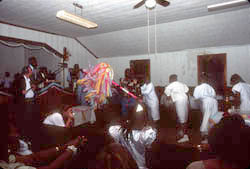
Annie Staten had been asked to serve as the mistress of ceremonies for the occasion, and I was there doing audio and still photography. Undoubtedly, our presence had a major impact on the event.
With its initial success, we decided to program the rock again for the 1995 Louisiana Folklife Festival, but because of other festival assignments, I was not available to assist in the Easter Rock presentation. However, folklorist Joyce Jackson and community scholar Annie Staten served as presenters. While I was disappointed about not moderating the rock, I thought it appropriate to have African American scholars doing the presenting of this African American tradition since they were familiar with the ritual having participated in its documentation. I was not sure how the rock had been presented in those subsequent years, but Addison told me that they had continued to present the rock at public festivals the way she and I had designed it initially.
As the ensemble became more experienced, members of the group presented the essential information without questions from the presenters, as evidenced by festival stage recordings. Before Lionel Wilson moved to Georgia, he often served as the spokesperson on narrative stages. His presentations sometimes included information that was undoubtedly learned from the presenters. For example, in 2003 Wilson uses the scholarly term "Call and Response" (a term I had used initially) to describe the performance of the "Oh, David" spiritual and to explain the symbolism of ritual and its circular banner:
The Easter Rock is a call and response. You have a caller who will call out to the crowd and to the other rockers and they will respond. In the rock today you will notice that there will be a song that will be sang and it is a call and response. It is a song of David who was the victor over the giant Goliath and so therefore since David was a victor we sang a song of victory because Jesus Christ had victory over the grave on the third day morning and that's why we rock to a risen savior. You will notice that as we come around to the table you will see different items being placed on the table. One of them will be cakes, there will be 12 cakes placed on the table which represents the 12 disciples. You will have 12 lanterns on the table which represents the 12 tribes of Israel. You will also notice that there will be some red punch on the table, it used to be red wine but now we serve red punch instead of wine, and that represents the blood of Jesus Christ. The white that we see here symbolized purity, the eggs on the table behind me represent the grave and the breaking of the grave when Jesus rose from the grave with all power in his hand. You will notice that there will be a person in the front carrying a banner, the banner represents the cross. The banner will not be a cross, but it will be a circle, which represents the continuation of life. The circle is covered with different colors to add just a little symbolism to Easter and during the time of Easter. (2003) 6
His discussion of the origin and meaning of the circle and the banner echoes Joyce Jackson's 1997 narrative stage introduction:
A circular ritual in the church, . . . [Easter Rock] is a carry over from the African Diaspora, and you can see that they are using a round banner which symbolized a cross. Well, that is not so foreign either, although you don't see round crosses normally in Baptist Churches, but if you look at the literature and you look at traditional African religions and those in the Caribbean, you find that the circle is very important, not only in the way that they move around the church and around the table but also in the worship and in the life cycle. If you look at life, it's like a circle and this circle was very instrumental in the way that they worshipped and looked at life, or the worldview. When you are born it's like you are at the 12 o'clock position and as you go through life you move around that circle, or the circle of life. And so the circle is very important in African traditions and so again it's sort of a carry over in this rocking tradition.
Wilson's eloquent remarks in this 2003 presentation are similar to his earlier 2001 presentation (below) which also discusses the symbolism of the Rock; a comparison of these illustrates the formulaic nature of his presentations:
The Easter Rock is a tradition that we perform in Winnsboro, Louisiana at the original True Life Baptist Church located on Highway 4 in Winnsboro. It is done the Saturday before Easter. It is a circular dance that we do in the black church; it's a rhythmic rock from side-to-side as the caller is singing a song talking about "Oh David." The song "Oh David" is a victory song, it tells the story of David and Goliath, when David went out on the battle field and slew the mighty giant Goliath. He was victorious in that battle and that is why we use the song "Oh David" because Jesus we know he was victorious over the grave for he died and he rose again. Here this afternoon, well this evening, what you will see will be a table that is dressed in white and on the table you will notice that there will be 12 cakes placed on the table which represents the 12 disciples. And you will notice that there will be 12 lanterns which represent the 12 tribes of Israel, you will also notice that there will be some punch placed on the table, some red punch, which symbolized the blood of Jesus. Before the punch was introduced into the scene they had real wine that they would drink after the Easter Rock but now we use regular punch of the color red to symbolize the blood of Jesus. Also on the table you will see the basket which represents the grave, the eggs which represents the breaking of the grave when Jesus rose on the third day morning. You will also notice we are dressed in white which symbolizes purity. You will notice that there will be a banner carried by the first person that is leading the rock. That person is carrying the banner as Jesus carried the cross. The banner is in a circular diagonal form and the reason for is there is no ending to a circle and it represents Jesus' life because there is no ending to Jesus for we know that he lives now and forever more. (2001)
Because of the great success of Easter Rock in the Louisiana Folklife Festival, I recommended it for other festivals including the New Orleans Jazz and Heritage Festival and the 1997 Smithsonian Festival of American Folklife, which featured the Lower Mississippi Delta. They were invited to be listed in the Louisiana Division of the Arts Touring Directory 2000-2002 and subsequently, were featured in a state arts presenter training program, where they performed Easter Rock at the Dixie Theater in Ruston, Louisiana. This led to subsequent in-state and regional performance opportunities. Over the years they were also presented by in-state museums including the Delta Music Museum at Ferriday, the Masur Museum of Art, and the African American Museum in Monroe. All of these performances were accompanied by publicity in newspapers and promoted a growing local audience for its annual Easter eve performance at the church.
Asked what she liked best about the travel made possible through their sharing of Easter Rock, Hattie Addison responds with her favorite festival experiences:
Meeting people, meeting a lot of people, especially in Washington! Rufus Thomas, I never thought I'd meet Rufus Thomas while I was there. . . I never thought I'd have saw that man [who did] "Walking the Dog" . . . I liked Washington. I liked Smithsonian. I liked New Orleans, I loved New Orleans. . . . I had to give out so many cards to people, and then I've heard from a lot of them when they wanted to come for the rock and I met a lady from New York that was there and she wanted to fly out and come to the Easter Rock. (2011)
Addison also noted that at the Smithsonian Festival, they first met people from Africa. She describes them joining in the rock on stage: "They rocked with us and they were doing another little rock, I don't know what it was, but anyway the man was the leader. . . . it was something, I mean we were shocked, I mean it just shocked me the way they were doing it and he had a walking stick in his hand when he was rocking, this older guy and he would rock from one side to the other . . . and he said that they would do that every Sunday." Thus, the Winnsboro Easter Rock Ensemble's public presentation of the rock facilitated encounters with myriad white audiences (the predominant festival attendees) as well as Africans from the rockers' ancestors' native land, and they all rocked together.
The Significance of Place
With these presentations only minor changes in the elements of the rock have occurred, but the Winnsboro Easter Rock Ensemble has had to respond to major problems with their venue, the Original True Light Baptist Church. Four years ago, Addison discovered at the last minute before the rock that there were plumbing problems in the bathroom of the Original True Light Baptist Church, so she was forced to rent the local VFW Hall, which, fortunately, also had a wooden floor, which sounded great. She thought the building worked out well, but the next year when the church was having even more problems with broken pews and disputed ownership of the church, she turned again to the VFW hall, only to find it rented out as a church.
Addison reported the venue problems to the new Winnsboro mayor, Jackie Johnson, who had attended Easter Rock at the church a couple of times before. He had the idea of the group renting the town's new community center in the newly remodeled grocery store for a fee of $300, which was more expensive than the $160 charged for the VFW Hall. In spite of the expense and the fact that the center lacked a wooden floor, Addison decided to rent the center; she put out some local publicity and made a sign for the building.
According to Addison, Easter Rock serves as a sort of homecoming event; the 2011 Easter Rock at the community center brought in people from Rayville, Vidalia, Monroe, Texas, and Illinois. In fact, they had more people than usual, using all of the 200 chairs put out for the event. People were able to park downtown, whereas parking at the rural church was so limited that most people had to park on the shoulder of the road and walk down the road to the church, and if it had been raining, cars could get stuck. Many who did not want to walk that far at night just gave up when the event was at the church, as Addison explained, "I've had a lot of them tell that they came home for the rock and with the way the parking was they just went on back home. This [the community center] was a lot of convenience for people. . . Some of them love it because they say it's more comfortable, they says it's not as crowded, you're not just right up on you. I noticed this year, that's the biggest we've ever had because we had people from everywhere" (2011).
The next year, the group decided to use the Princess Theater, a restored historic movie theater built in the early 1900s, because the rental fee was less expensive and the stage floor for the rock was wooden. However, before the rock began, one of the rockers announced that the lamps would not be lighted because the theater's policy would not permit this. Then the rockers marched in with the unlighted lamps and placed them on the table and continued with the rock.
Each of the venues presented various difficulties, which Addison dealt with creatively. None of the alternative venues were churches and, thus, did not have pulpits, although a podium was set up in each instance, and all the speakers and singers, including the minister, used it. In 2011 in the community center, a small music-stand type podium with microphone was centered against the back wall, some feet from the door where the rockers would enter. In 2012 in the theater, the podium was placed on the floor in front of the stage, where the rock would take place. Rockers entered through the theater doors and came down the aisle to the stage. In her work on the Easter Rock, folklorist Joyce Jackson notes that the mistress of ceremonies "took her place at the dais on the floor beside the elevated pulpit. Even during this female-driven event, the male minister was still the only male in the pulpit" (2006:103). This podium placement in non-sacred venues puts the women directing the event on the same level as the minister, seemingly democratizing the event and playing down the role of the minister. While the 2011 Easter Rock had a minister deliver a call to join the church after the rock portion of the service, the 2012 rock did not have a sermon delivered by a minister; instead it was directed entirely by the "Mistress of Ceremony," "Sis. Katie Matthew," who had the same role at the previous year's rock. Her multiple talents of speaking, singing, generating audience response, and orchestrating the whole event made the absence of the minister unnoticed.
Although the altered context and the absence of the minister may challenge or compromise the sacred nature of the event, the event has actually become more prominent in the community and had broader participation. The downtown Winnsboro venues have allowed more public visibility of the event through signage. The group's use of these alternative venues illustrates their creative adaption to the disruption which could have destroyed the tradition as it did in the case of the Clayton Easter Rock. When the Springfield Baptist Church was rebuilt with a concrete slab construction, the Clayton Easter Rock was discontinued, whereas this has not happened with the Winnsboro Rock, even in 2011 when the rock was held in the community center which had a concrete floor. They had debated putting down plywood over the area to be used for the rock, but decided against it because of the expense and difficulty. Because of Addison's determination to continue the family tradition and because of their public presentation experience where they learned to perform the rock in a variety of venues, the Winnsboro group has been able to adapt to new performance contexts.
The Future of the Easter Rock
According to Addison, the future of Easter Rock is hopeful in spite of her problems with the local church building because of its appeal to the children: "The children love it, the young children love it, and every year there is more and more being added to it. I think it will continue. If I can't [continue], I know my children would, [and] my grandchildren would be interested in keeping it going" (2011). While maintaining the interest of the performers is no problem, the rental fees, ranging from $160-$500 or more) for community buildings continue to pose difficulty for the Winnsboro rock. Certainly, holding Easter Rock in a home church offers the sacred context and no rental fee; hence it is a better financial option for the group since they don't charge an entry fee. However, without the church each year the group faces the dilemma of finding a financially feasible place to hold the rock. While Hattie Addison would prefer to use the deteriorating church again, she says she would also hold the rock in the community center and put down some plywood sheets for the rockers. Ultimately, Hattie Addison has dreams of getting their own building (or the True Light Church) where they could also have other "spiritual events": "If I had the money, I would build me a building like that [the VFW Hall]" (2011). In the meanwhile, she would like to continue to do public performances, and she has asked for help in getting other festival bookings, especially, at the New Orleans Jazz and Heritage Festival, where their audience would not let them stop rocking. These memorable public presentations of Easter Rock have empowered the group to reach beyond their home town Easter Rock service to celebrate their roots and share their heritage with the world. Experiences such as these have illustrated to the group the value of their tradition and have created a stronger bond within the members of the group.
While a group of 12-20 participants have performed in the Winnsboro Easter Rock over the years, at least four generations of the Addison family have been the center of the rock. Without doubt, Ellen Addison was the driving force that encouraged her daughter Hattie to keep the Easter Rock alive. If it were not for her, the last known practitioners of this tradition would not have been taught the tradition. However, a major threat arose before the 2012 Easter Rock when Ellen Addison was in the last stages of terminal cancer. She insisted that Hattie go on with the rock that night instead of staying with her. Her illness had prevented her daughter from doing as much publicity for it, and the crowd was somewhat smaller than the year before. Nevertheless, the rockers rocked, happy to be back on a wooden floor, even if it was a historic theater stage and their lamps were dark. Their voices rang out and their feet sounded the beat of the drum.
Notes
1. This essay is dedicated to the memory of Ellen Addison, the matriarch of the Winnsboro Easter Rock, who passed away in April 2011 and to Hattie Addison for her efforts to keep the Easter Rock alive and share it with others. She welcomed our documentary efforts numerous times and helped us with our research. I am also grateful to Delta Folklife Project community scholar, Annie Staten, who located the Winnsboro group and facilitated our initial research efforts with this group. I would like to acknowledge other members of the Winnsboro Easter Rock Ensemble over the years: Jimmie Lamb, Jimmie Lee Jones, Laketa Addison Levy, Jessie White, Ashley Winn, Ella Washington, Britney Cook, Christy Cook, Azzie Lee Jackson, Booker T. Burkhalter, Lionel Wilson, Lillie Carter, and callers Jimmy Brown and Fred Ross.
2. Initial fieldwork on Easter Rock for the Delta Folklife Project was conducted by Susan Roach and Annie Staten, who located the Winnsboro Easter Rock. Roach and Staten documented the 1994 and 1995 Easter Rock services. In addition, Staten also interviewed Hattie and Ellen Addison, Katie King, Molly Neal, and Andrew Watkins as part of the Delta fieldwork. From 1995-2004, the Winnsboro Easter Rock was presented at the Louisiana Folklife Festival in Monroe, where it was recorded. Roach did follow up fieldwork including interviews with Hattie Addison and audio, video, and photographic documentation of the Winnsboro Easter Rock services in 2011 and 2012.
3. Sturman (1993:27) refers to Charlotte Forten's 1864 description of a ring shout in the Georgia Sea Islands that prefigures the Easter Rock ceremony (see Epstein 1977: 279-280). Jackson also discusses a Caribbean ring shout tradition (Jackson 2006)
4. Lea and Marianna Seale note that Tobias and Elizabeth Scott, elderly African Americans from Haphazard Plantation in Ferriday, La., were children during the Civil War and were "familiar with the Easter rock ceremony since childhood" (1942: 213).
5. In 2012 I was honored when Hattie Addison asked me to present the "Occasion." She had asked Annie Staten to do this in 1995, the year after we had first documented the event. For Staten, who was raised in the African American Baptist Church and a frequent speaker in various church services, this was an easy task. For me, an Anglo-American, it was atypical to speak in church, although I had explained the event to festival audiences when we began to present Easter Rock at folklife festivals. In 2011 Addison had asked me to help with the offering. For a discussion of the folklorist in hybrid roles and folk artists becoming their own presenters, see Regis and Walton.
References
Addison, Ellen, and Hattie Addison. 1994. Personal interview by Annie Staten, 29 December.
Addison, Hattie. 2011. Personal interview. 5 October.
Baron, Robert and Nicholas Spitzer, eds. 1992. Public Folklore. Washington, D.C.: Smithsonian Institution.
Baron, Robert. 2010. "Sins of Objectification? Agency, Mediation, and Community Self-Determination in Public Folklore Cultural Tourism Programming." Journal of American Folklore 123.487 (Winter): 69-91.
Daniels, Martha. n.d. Personal communication.
"Easter Rock" Service. 1994. Original True Light Baptist Church, Winnsboro, 2 April.
---. 1995. Original True Light Baptist Church, Winnsboro, 15 April.
---. 2011. Jack Hammons Community Center, Winnsboro, 23 April.
---. 2012. Princess Theater, Winnsboro, 7 April.
---. 2013. Jack Hammons Community Center, Winnsboro, 30 March.
"Easter Rock." 1997. Presentation Recording. Louisiana Folklife Festival, 13 September.
---. 1998. Presentation Recording. Louisiana Folklife Festival, 12 September.
---. 2001. Presentation Recording. Louisiana Folklife Festival, 10 September.
---. 2003. Presentation Recording. Louisiana Folklife Festival, 13 September.
Epstein, Dena J. 1997. Sinful Tunes and Spirituals: Black Folk Music to the Civil War.> Urbana: Univ. of Chicago P.
Gregory, H. F. 1962. "Africa in the Delta." Louisiana Studies. 1.l: 16-22.
Hamilton, Dee, ed. 2000. Louisiana Touring Directory 2000-2002. Baton Rouge: Louisiana Division of the Arts, 40.
Jackson, Joyce. 2006. "Rockin' and Rushin' for Christ: Hidden Transcripts in Diasporic Ritual Performance." Caribbean and Southern: Transnational Perspectives on the U. S. South, ed. Helen Regis. Athens, Ga.: University of Georgia Press, 89-123.
King, Katie. 1994. Personal interview by Annie Staten, 29 July.
Kelly, R. B. 1994. Personal interview. 2 April.
Oster, Harry. 1958. "Easter Rock Revisited: A Study in Acculturation." Louisiana Folklife Miscellany. 3(1958): 21-43.
---, n.d.with the Louisiana Folklore Society. "A Sampler of Louisiana Folksongs, sung by traditional performers." LSF-1201.
Regis, Helen A., and Shana Walton. 2008. "Producing the Folk at the New Orleans Jazz and Heritage Festival." The Journal of American Folklore. 121.482 (Fall): 400-440.
Roach, Susan. 2008. "Easter Rock: A Description" Louisiana Folklife. Web. 28 March 2008.
Seale, Lee, and Marianna Evans Seale. 1942. "Easter Rock: A Louisiana Negro Ceremony." Journal of American Folklore 55: 212-218.
Sturman, Janet L. 1991. Easter Rock video excerpt. Springfield Baptist Church.
---. 1993. " Asserting Tradition: The Building and Maintenance of African-American Baptist Rock Ceremony in Northeast Louisiana.." Louisiana Folklife. 17 (1993): 24-32.



